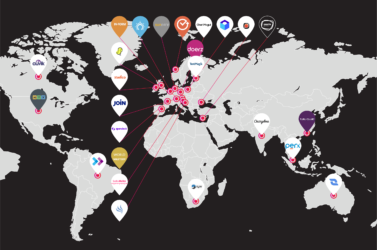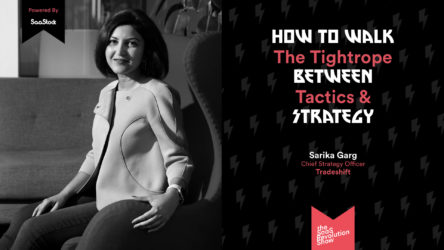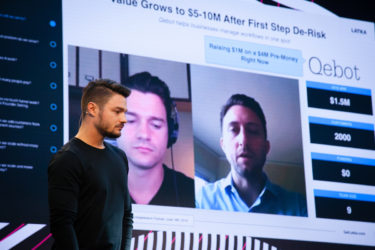600 scheduled investor meetings, equally as many randomly encountered ones. 400 questions posted on Slido during 84 sessions, 3000 cups of coffee, 1973 hashtag mentions. Millions of impressions. These are the preliminary numbers coming out of SaaStock17.
When you are the organiser of a conference, you get to devour data like that to understand what happened while you were behind the scenes making sure everything runs smoothly.
What we also rely on is the kind words of attendees, either said in person at the parties or spelled out underneath the NPS score. As the first results came in, a few stood out
Easy and approachable people.
A mini MBA!
You guys smashed it.
Love SaaStock!
We built SaaStock for SaaS founders, executives and investors to learn from each other and connect with one another.
Below we have gathered some of the concrete lessons, and take-outs attendees picked up.
We have a handful of Super Early Bird tickets left for SaaStock18. Grab one before October 2nd.
Amaan Nathoo, Bonjoro, Australia
Aussies from Bonjoro particularly enjoyed the lack of ego they saw at SaaStock and the genuine nature of interactions. They also loved the star lineup of speakers from all corners of Europe as well as the US, Canada, Australia, and Asia representing every level of SaaS – startups, SME, and Enterprise. Things that stood out for them:
“The Growth Bootcamp and Guillaume Cabane session on personalising experiences that delight people, even before they have actively engaged with the brand. Using tools like Clearbit to identify anonymous visitors to the website and MadKudu which helps lead score in real time, were a few of the ones he mentioned.
On the second day, Patrick Barnes from Advocately ran a great session on how to get to 100 trial sign-ups per month without writing content but rather using a product as a lead magnet.
The highlight of the final day of SaaStock was a great session on churn and customer retention by David Apple – VP of Customer Success at Typeform. David took us through his journey of segmenting Typeform users by their usage habits.
Whether you are a team of one just releasing your MVP, or an Enterprise solution looking to expand into Europe, there is something for you at SaaStock.”

Markko Vaarnas, Finland
For Markko, SaaStock represented an important realization just how much there is to learn about SaaS, even if you have been in the space for over a decade.
“At SaaStock I felt quite humble about my knowledge level of modern SaaS sales when listening to the experts of different fields of SaaS specialization such as marketing, inside sales and client success management. The rules of buying have really changed a lot when clients today have the option of finding lots of alternatives to their needs and trial them with a reasonable effort.
To summarize the key message of various speakers into one concrete piece of advice that would be – “be customer-centric”. Bill Macaitis, who has run the marketing for Salesforce.com, Zendesk and Slack, highlighted that the average Net Promoter Score of B2B software companies is -19! With new customer-focused SaaS companies, the number is likely to go up.”

Tony Corrigan, Tenderscout, Ireland
For the Tenderscout team of three SaaStock was all about new ideas and brilliant connections. Nothing they learned at SaaStock stays at SaaStock.
“Ryan Smith from Qualtrics inspired me and gave me encouragement to push on.
Another standout presentation was by Promise Phelon of TapInfluence about the essentials of strategic leadership. She went deep on strategy and tactics and lifted the lid on what transforming from services to SaaS looks like. Plus her no vampire rule cleared about 20% of backlog from my plate!”
More tender thoughts from Ireland

Pierre Lechelle, France
Pierre had a full-on experience and made use of every minute he had to meet like-minded French Saas mafia, pickup up vital lessons and interview seven of the speakers.
“You could start the day by speaking to a new founder, have lunch with one of the fastest growing SaaS companies and have a few beers with the French Mafia (there are a lot of French people in the SaaS space). In between those you could capture lessons such as:
- Don’t follow others. Don’t build a business for someone else. Don’t follow what others do and say because they’re different from you. Look deep inside of you and design the business that really suits you.
- It doesn’t have to be sexy. It doesn’t have to sell for $200M. Selling a small business can already change your life. Don’t listen to the press too much!
- Building (and selling) a business on top of another ecosystem (e.g., Xero) gives you a clear competitive advantage (you can rely on their user base).”
Who else did Pierre have lunch with

Alan Gleeson, UK
Similarly to last year, B2B marketer Alan Gleeson wrote up the ten lesson he picked up from the talks, while having a great time. Here are four:
Lead Generation is More than Just Inbound Marketing
Picked up by Nathan Barry and Greg Pietruszysnki there is a deficiency with inbound marketing as a dominant B2B SaaS marketing strategy arguing that it lacked a feedback loop. At least with direct sales calls, you can have conversations and understand objections.
Say No As A Default
As startups start to mature, feature requests come thick and fast. According to Des Traynor, it is vital that the default position for the majority was a hard no.
For Those Expanding into theUS, The First Sales Hire is Crucial
One of the key topics throughout the conference was expanding into the US. Hiring the first sales lead in the US is considered a key milestone but is one that is fraught with danger. After all, salespeople do what they do best which is to sell themselves, making it difficult to assess how good they really are. Notion Capital touched upon this during a special event, and so did David Skok.
Stop being lazy, talk to customers
As Patrick Campbell puts it, there is an inherent laziness of SaaS startups in talking to real customers. SaaS entrepreneurs need to stop being lazy and get out talking to customers to ensure they were building features of real value.
What are the other 6 lessons Alan picked up

Thomas Peham, Austria
Everyone kept on asking Thomas what was his one take out. Apart from discovering many new SaaS tools, he was unfamiliar with, SaaStock was all about Growth.
“As someone working in growth, it was particularly interesting to see many talks, sessions, and bootcamps focused on the topics of growth. Overall, I feel that there’s been a strong focus on growth, marketing, and sales-related topics at SaaStock17.
It was particularly interesting to see different examples of startups growing through a broad range of channels, such as outbound sales, paid ads, content marketing or SEO. There are so many ways to go.”

James Gill, GoSquared, UK
For James, SaaStock provided an epiphany what’s the focus SaaS companies should have: customers, not competitors.
“After days of talking with hundreds of other SaaS founders, employees, and investors, one thing’s clear: if you’re doing something in SaaS, you have competition. No field or industry or company is exempt from this intensely competitive environment.
But it doesn’t matter.
People buy from people they like and people they trust. They buy based on what they hear and what they feel. They buy to solve problems.
Build a great product that solves a really big, painful problem for your customers, and go out of your way to make them really happy.
Focus on your customers, not your competitors, and a lot will figure itself out.”
How is James becoming more customer-centric

Diego Gomez, Brazil
Hailing all the way from Brazil, Diego picked up these among many other lessons.
You can learn from your peers
Talk to as many Lead Gen leaders you can, read every book, in order to move fast. Do not worry about product training. Focus on integrating Demand Gen and Sales execs knowledge. Specialize Inbound/Outbound Demand Gen reps;
Align all levels
Document, share, communicate. Create shared incentive plans, structured communication channels and assure that the team trusts each other and its leaders.
Plan for big
Do the things right the first time around. What works for 20 people does not work for 100. Think about people, process, and technology early on.
Many more lessons Diego picked up

Alexander Peiniger, Germany
For Alexander, the conference provided an important benchmark as to where Quintly is and how bootstrappers compare to VC funded SaaS companies.
“In the 3 days, I talked to lots of people from the ecosystem and listened to 20+ talks. As a result, I now have a much better understanding of where we are with Quintly and how we stack up with our metrics against all the other SaaS companies around. I found a lot of people that also bootstrapped their company successfully, so it’s great to see that it still works although more and more companies are going the venture funding way.
The ecosystem as a whole has gotten much more structured compared to last year. Most of the people I talked to had a very good understanding of their metrics and all the growth, product and customer success processes seem much more professional.”
What other thoughts did SaaStock stir up in Alexander





